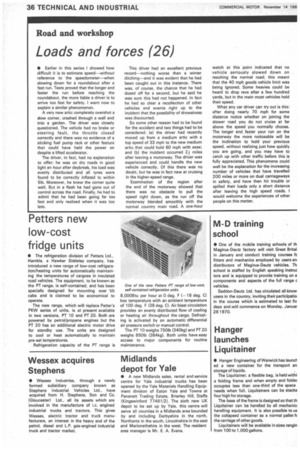Road and workshop
Page 38

If you've noticed an error in this article please click here to report it so we can fix it.
Loads and forces (26)
• Earlier in this series I showed how difficult it is to estimate speed—without reference to the speedometer—when slowing down for a roundabout after a fast run. Tests proved that the longer and faster the run before reaching the roundabout, the more liable a driver is to arrive too fast for safety. I want now to explain a similar phenomenon.
A very new artic completely overshot a slow corner, crashed through a wall and into a garden. The driver was closely questioned. The vehicle had no brake or steering fault, the throttle closed' correctly and there was no evidence of a sticking fuel pump rack or other feature that could have held the power on despite a lifted accelerator.
The driver, in fact, had no explanation to offer: he was an dry roads in good light an hour after daybreak, his load was evenly distributed and all tyres were found to be correctly inflated to within 51b. Moreover, he knew the corner quite well. But in a flash he had gone out of control across the road. Finally, he had to admit that he had been going far too fast and only realized wher it was too late. This driver had an excellent previous record—nothing worse than a winter ditching—and it was evident that he had been caught out in this instance. There was, of course, the chance that he had dozed off for a second, but he said he was sure this had not happened. In fact he had so clear a recollection of other vehicles and events right up to the incident that the possibility of drowsiness was discounted.
So some other reason had to be found for the accident and two things had to be considered: (a) the driver had recently moved up from a medium artic with a top speed of 33 mph to the new medium artic. that could hold 60 mph with ease; and (b) the incident occurred miles after leaving a motorway. The driver was experienced and could handle the new vehicle correctly. Of this there was no doubt, but he was in fact new at cruising in the higher-speed range.
Examination of the region after the end of the motorway showed that there was no obstacle to pull the speed right down, as the run off the motorway blended smoothly with the normal country main road. A one-hour watch at this point indicated that no vehicle seriously slowed down on reaching the normal road; this meant that the 40 mph goods vehicle limit was being ignored. Some heavies could be heard to drop revs after a few hundred yards, but in the main most vehicles held their speed.
What any car driver can try out is this: after doing nearly 70 mph for some distance notice whether on joining the slower road you do not cruise at far above the speed you normally choose. The longer and . faster your run on the motorway the more noticeable will be the inclination to hold your previous speed, without realizing just how quickly you are going, and you may have to catch up with other traffic before this is fully appreciated. This phenomena could well be the explanation for the increasing number of vehicles that have travelled 200 miles or more on dual carriageways in safety, and have then hit trouble or spilled their loads only a short distance after leaving the high speed roads. would welcome the experiences of other people on this matter.




















































































































